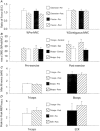Central and peripheral mediation of human force sensation following eccentric or concentric contractions
- PMID: 11897860
- PMCID: PMC2290170
- DOI: 10.1113/jphysiol.2001.013385
Central and peripheral mediation of human force sensation following eccentric or concentric contractions
Abstract
Fatigue was induced in the triceps brachii of the experimental arm by a regimen of either eccentric or concentric muscle actions. Estimates of force were assessed using a contralateral limb-matching procedure, in which target force levels (25 %, 50 % or 75 % of maximum) were defined by the unfatigued control arm. Maximum isometric force-generating capacity was reduced by 31 % immediately following eccentric contractions, and remained depressed at 24 (25 %) and 48 h (13 %) post-exercise. A less marked reduction (8.3 %) was observed immediately following concentric contractions. Those participants who performed prior eccentric contractions, consistently (at all force levels), and persistently (throughout the recovery period), overestimated the level of force applied by the experimental arm. In other words, they believed that they were generating more force than they actually achieved. When the forces applied by the experimental and the control arm, were each expressed as a proportion of the maximum force that could be attained at that time, the estimates matched extremely closely. This outcome is that which would be expected if the estimates of force were based on a sense of effort. Following eccentric exercise, the amplitude of the EMG activity recorded from the experimental arm was substantially greater than that recorded from the control arm. Cortically evoked potentials recorded from the triceps brachii (and extensor carpi radialis) of the experimental arm were also substantially larger than those elicited prior to exercise. The sense of effort was evidently not based upon a corollary of the central motor command. Rather, the relationship between the sense of effort and the motor command appears to have been altered as a result of the fatiguing eccentric contractions. It is proposed that the sense of effort is associated with activity in neural centres upstream of the motor cortex.
Figures





Similar articles
-
Eccentric exercise increases EMG amplitude and force fluctuations during submaximal contractions of elbow flexor muscles.J Appl Physiol (1985). 2007 Sep;103(3):979-89. doi: 10.1152/japplphysiol.01310.2006. Epub 2007 Jun 28. J Appl Physiol (1985). 2007. PMID: 17600154
-
Corticospinal Modulations during Motor Imagery of Concentric, Eccentric, and Isometric Actions.Med Sci Sports Exerc. 2020 May;52(5):1031-1040. doi: 10.1249/MSS.0000000000002218. Med Sci Sports Exerc. 2020. PMID: 31764463
-
Muscle length effect on corticospinal excitability during maximal concentric, isometric and eccentric contractions of the knee extensors.Exp Physiol. 2017 Nov 1;102(11):1513-1523. doi: 10.1113/EP086480. Epub 2017 Sep 30. Exp Physiol. 2017. PMID: 28796385
-
Transcranial magnetic stimulation and human muscle fatigue.Muscle Nerve. 2001 Jan;24(1):18-29. doi: 10.1002/1097-4598(200101)24:1<18::aid-mus2>3.0.co;2-d. Muscle Nerve. 2001. PMID: 11150962 Review.
-
Neural adaptations to resistive exercise: mechanisms and recommendations for training practices.Sports Med. 2006;36(2):133-49. doi: 10.2165/00007256-200636020-00004. Sports Med. 2006. PMID: 16464122 Review.
Cited by
-
Asymmetry in grasp force matching and sense of effort.Exp Brain Res. 2012 Mar;217(2):273-85. doi: 10.1007/s00221-011-2991-6. Epub 2012 Jan 5. Exp Brain Res. 2012. PMID: 22218499
-
Ventilatory response to moderate incremental exercise performed 24 h after resistance exercise with concentric and eccentric contractions.Eur J Appl Physiol. 2011 Aug;111(8):1769-75. doi: 10.1007/s00421-010-1801-3. Epub 2011 Jan 9. Eur J Appl Physiol. 2011. PMID: 21221990 Clinical Trial.
-
The senses of force and heaviness at the human elbow joint.Exp Brain Res. 2013 May;226(4):617-29. doi: 10.1007/s00221-013-3476-6. Epub 2013 Mar 23. Exp Brain Res. 2013. PMID: 23525562
-
The senses of active and passive forces at the human ankle joint.Exp Brain Res. 2015 Jul;233(7):2167-80. doi: 10.1007/s00221-015-4287-8. Epub 2015 May 1. Exp Brain Res. 2015. PMID: 25929549
-
Mechanisms of force depression caused by different types of physical exercise studied by direct electrical stimulation of human quadriceps muscle.Eur J Appl Physiol. 2016 Dec;116(11-12):2215-2224. doi: 10.1007/s00421-016-3473-0. Epub 2016 Sep 16. Eur J Appl Physiol. 2016. PMID: 27637589 Free PMC article. Clinical Trial.
References
-
- Avela J, Kyröläinen H, Komi PV, Rama D. Reduced reflex-sensitivity persists several days after long-lasting stretch-shortening cycle exercise. Journal of Applied Physiology. 1999;86:1292–1300. - PubMed
-
- Boring EG. The relation of the attributes of sensation to the dimensions of the stimulus. Philosophy of Science. 1935;2:236–245.
-
- Brockett C, Warren N, Gregory JE, Morgan DL, Proske U. A comparison of the effects of concentric versus eccentric exercise on force and position sense at the human elbow joint. Brain Research. 1997;771:251–258. - PubMed
Publication types
MeSH terms
Substances
LinkOut - more resources
Full Text Sources

